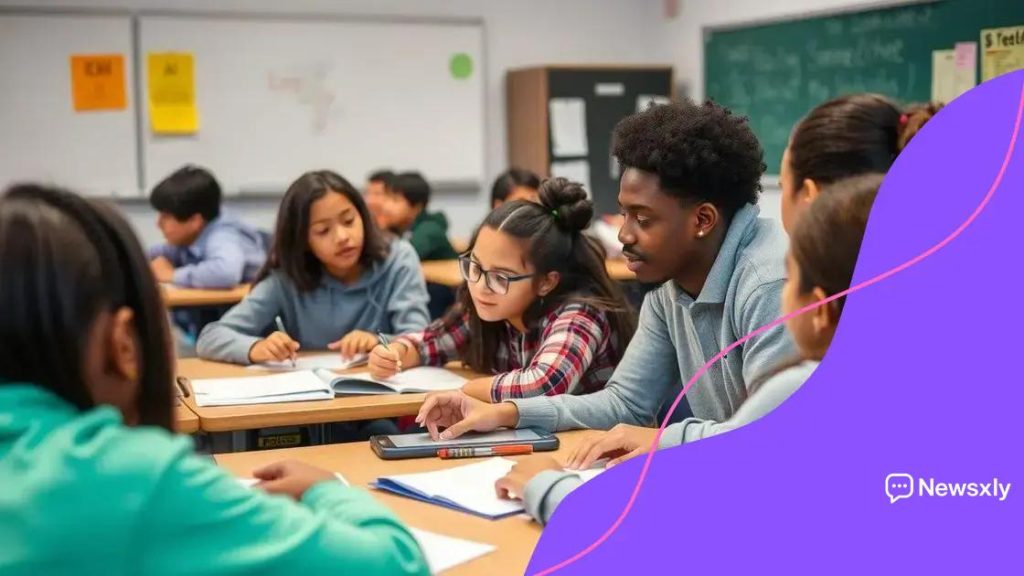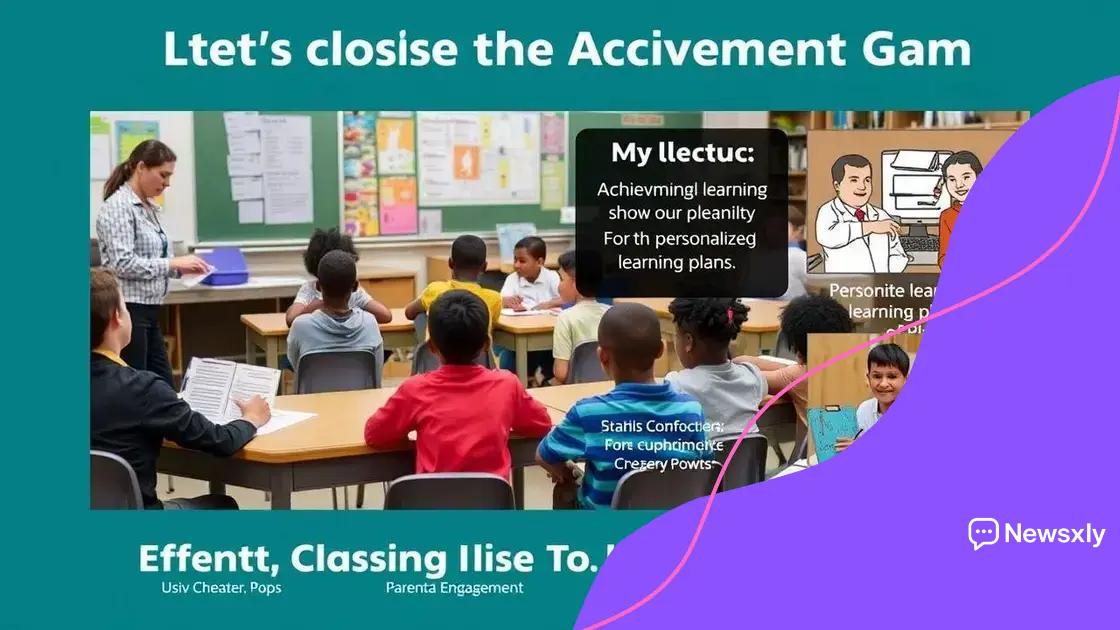Addressing the achievement gap in schools effectively

Addressing the achievement gap in schools requires community involvement, teacher engagement, and tailored learning strategies to ensure equitable educational outcomes for all students.
Addressing the achievement gap in schools is vital for creating equitable learning environments. Have you thought about how this impacts students’ futures? Let’s dive into effective strategies and insights.
Understanding the achievement gap
Understanding the achievement gap is essential for promoting equity in education. This gap showcases the disparities in academic performance among different groups of students. Recognizing these differences is the first step toward addressing them.
What is the achievement gap?
The achievement gap refers to the observed disparity in educational performance between various groups of students, often categorized by socioeconomic status, race, and ethnicity. By identifying these groups, educators can focus on tailored solutions.
Causes of the achievement gap
Several factors contribute to the achievement gap. Here are some key elements:
- Access to quality education
- Socioeconomic status
- Parental involvement
- Cultural and language barriers
Addressing these causes requires a comprehensive understanding of each contributing factor. For instance, students from low-income families often face challenges that impede their learning.
Additionally, systemic issues in schools, such as funding disparities and resource allocation, play a significant role in the achievement gap. Schools in affluent areas often have more resources, leading to better educational outcomes.
Impact on students
The implications of the achievement gap are profound. Students who fall behind academically due to systemic inequities may experience lasting effects on their lives. They might struggle with self-esteem or face barriers in higher education opportunities.
It’s crucial to recognize that the achievement gap does not define a student’s potential. With the right support, all students can succeed, regardless of their background. Educators and communities must work collaboratively to create equitable learning environments.
Factors contributing to the achievement gap
There are several factors contributing to the achievement gap that affect students in various ways. Understanding these factors is crucial for educators, parents, and communities to create effective interventions.
Socioeconomic Status
One of the primary factors is socioeconomic status. Students from low-income families often lack access to essential resources such as tutoring, extracurricular activities, and even basic school supplies. This disadvantage can hinder their academic progress.
Parental Involvement
Parental involvement plays a significant role in a child’s education. When parents are engaged in their children’s academic journey, students tend to perform better. Unfortunately, many parents may not have the time or knowledge to assist, especially if they have low educational backgrounds themselves.
- Parents can create a supportive home environment.
- Communication between school and home is key.
- Involvement in school events fosters community and support.
Furthermore, the schools that students attend can differ greatly in terms of funding and resources, which influences academic outcomes. Schools in affluent areas may have advanced facilities and experienced teachers, while those in lower-income areas may struggle with limited resources.
Cultural and Language Barriers also contribute to the achievement gap. Students from non-English speaking families may find it challenging to keep up with lessons delivered in English. These barriers can create misunderstandings and lead to a lack of confidence in their abilities.
Lastly, the school environment itself plays a crucial role. A positive school climate can encourage learning, while a negative atmosphere can detract from student performance. Educators must ensure that every student feels safe and accepted.
Effective strategies for closing the gap

Effective strategies for closing the achievement gap are essential for enhancing educational equity. By implementing targeted approaches, schools can help all students succeed.
Customized Learning Plans
One promising method is creating customized learning plans for students. These plans take into account individual strengths and weaknesses, allowing educators to tailor their instruction to fit each student’s needs.
Enhanced Teacher Training
Enhanced teacher training is another vital strategy. Providing teachers with the tools and skills they need to support diverse learners can lead to better student outcomes. Workshops and professional development sessions that focus on cultural competence and inclusive teaching practices are essential.
- Teachers can learn new techniques for engagement.
- Collaborative teaching approaches can be employed.
- Mentorship programs can be established.
In addition, schools should foster partnerships with community organizations to provide additional resources and support. When schools collaborate with local groups, they can offer students enrichment opportunities that may be otherwise unavailable.
Tutoring and Mentoring Programs are also critical. Tutoring can provide personalized assistance to those struggling academically, while mentoring can offer guidance and encouragement. When students know they have someone to turn to, they are more likely to thrive.
Parental Engagement
Encouraging parental engagement in education is fundamental. Schools should create programs that invite families to participate actively in their children’s learning. Workshops that teach parents how to support their children at home can lead to improved academic success.
Finally, continuous assessment and feedback are necessary to ensure that these strategies are working. Educators should regularly evaluate student progress and adjust their approaches based on what the data shows. By remaining flexible, schools can make timely improvements that benefit students.
The role of teachers in addressing disparities
The role of teachers in addressing disparities within the achievement gap is crucial for fostering an equitable educational environment. Teachers serve as frontline advocates, influencing student success.
Culturally Responsive Teaching
One effective approach is culturally responsive teaching. This method encourages teachers to recognize the unique cultural backgrounds of their students. By integrating diverse perspectives into the curriculum, educators can engage students and make learning more relevant.
Building Relationships
Building strong relationships with students is fundamental. When teachers take the time to understand their students’ individual needs, interests, and challenges, they can provide better support. Positive teacher-student relationships foster trust and encourage students to participate actively in their education.
- Regular check-ins can enhance student engagement.
- Open communication creates a supportive classroom environment.
- Empower students by involving them in decision-making.
Teachers also play an essential role in recognizing and addressing learning barriers. By observing students closely, they can identify signs of struggle and implement interventions such as specialized tutoring or additional resources. This proactive approach helps ensure that no student falls behind.
Moreover, professional development focused on equity can equip teachers with the necessary tools to address disparities effectively. Workshops that highlight strategies for inclusivity and differentiation can boost teacher confidence and effectiveness.
Collaboration with Families
Teachers should also work collaboratively with families to support student learning outside of school. This partnership can enhance academic outcomes as parents become more involved in their children’s education. Providing resources and guidance to families helps create a consistent support system.
In conclusion, teachers are pivotal in addressing disparities in the achievement gap. Through culturally responsive practices, relationship-building, and collaboration with families, educators can make a significant impact in closing the gap and promoting equitable education for all students.
Community involvement in education
Community involvement in education plays a vital role in closing the achievement gap. When communities come together to support their local schools, students benefit greatly. Community members can provide resources, volunteer time, and help foster a supportive learning environment.
Collaboration with Local Organizations
Working with local organizations can enhance educational opportunities. Schools can partner with nonprofits, businesses, and community groups to develop programs that benefit students. These partnerships can lead to:
- After-school tutoring programs to assist struggling students.
- Workshops that teach parents how to help with homework.
- Mentorship programs pairing students with professionals.
Such collaboration brings diverse experiences into the classroom, enriching students’ learning. It also helps create a network of support that extends beyond the school walls.
Volunteer Programs
Creating volunteer programs allows community members to actively participate in education. Parents and local residents can volunteer in classrooms, assist in organizing events, or help with extracurricular activities. This involvement not only supports teachers but also strengthens the bond between the school and the community.
Moreover, volunteers can serve as role models, demonstrating the importance of education to students. When students see adults valuing education, they are more likely to take their studies seriously.
Hosting Community Events
Schools can host community events to gather families and encourage participation. Events like open houses, cultural festivals, or educational fairs invite discussions about the achievement gap and ways to address it together. These gatherings foster a sense of belonging and highlight the shared goal of student success.
Engaging the community in education is essential. When families and local organizations are involved, students experience a richer learning environment. This collaboration not only helps close the achievement gap but also builds a strong foundation for future success.
FAQ – Frequently Asked Questions about Addressing the Achievement Gap
What is the achievement gap?
The achievement gap refers to the disparities in academic performance between different groups of students, often influenced by socioeconomic status, race, and ethnicity.
How can community involvement help in education?
Community involvement brings additional resources, support, and engagement, enhancing the overall educational environment for students.
What role do teachers play in addressing educational disparities?
Teachers foster a supportive atmosphere, implement tailored learning strategies, and build strong relationships with students to help close the achievement gap.
What can parents do to support their children’s education?
Parents can engage by participating in school events, communicating with teachers, and creating a positive home learning environment.





